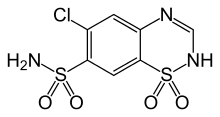Chlorothiazide
 | |
 | |
| Clinical data | |
|---|---|
| Trade names | Diuril |
| AHFS/Drugs.com | Monograph |
| MedlinePlus | a682341 |
| Pregnancy category |
|
| Routes of administration | Oral, IV |
| ATC code | |
| Legal status | |
| Legal status |
|
| Pharmacokinetic data | |
| Bioavailability | low |
| Metabolism | Nil |
| Biological half-life | 45 to 120 minutes |
| Excretion | Renal |
| Identifiers | |
| |
| CAS Number | |
| PubChem CID | |
| IUPHAR/BPS | |
| DrugBank | |
| ChemSpider | |
| UNII | |
| KEGG | |
| ChEBI | |
| ChEMBL | |
| ECHA InfoCard | 100.000.368 |
| Chemical and physical data | |
| Formula | C7H6ClN3O4S2 |
| Molar mass | 295.72 g/mol |
| 3D model (JSmol) | |
| |
| |
| (verify) | |
Chlorothiazide sodium (Diuril) is an organic compound used as a diuretic and as an antihypertensive.[1]
It is used both within the hospital setting or for personal use to manage excess fluid associated with congestive heart failure. Most often taken in pill form, it is usually taken orally once or twice a day. In the ICU setting, chlorothiazide is given to diurese a patient in addition to furosemide (Lasix). Working in a separate mechanism than furosemide, and absorbed enterically as a reconstituted suspension administered through a nasogastric tube (NG tube), the two drugs potentiate one another.
It was discovered in 1957.[2]
Indications
- Large amount of excess fluid including:
- Diagnosed congested heart failure
- Peripheral edema
- Rales / Rhonchi
- Hypertension
Contraindications
- Renal failure or insufficiency
- Allergies to sulfa drugs
Side effects
- Nausea / Vomiting
- Headache
- Dizziness
- Excess urine production
- Dehydration
- Hypoelectrolytemia (esp. hypokalemia / hypomagnesia)
History
The Research team of Merck Sharp and Dohme Research Laboratories of Beyer, Sprague, Baer, and Novello created a new series of medications, the thiazide diuretics, which includes chlorothiazide. They won an Albert Lasker Special Award in 1975 for this work.[3]
References
- ↑ Ernst, Michael E.; Grimm, Richard H., Jr. "Thiazide diuretics: 50 years and beyond" Current Hypertension Reviews 2008, volume 4(4), pp. 256-265. doi:10.2174/157340208786241264
- ↑ Walker, S. R. (2012). Trends and Changes in Drug Research and Development. Springer Science & Business Media. p. 109. ISBN 9789400926592.
- ↑ http://www.laskerfoundation.org/awards/formaward.htm